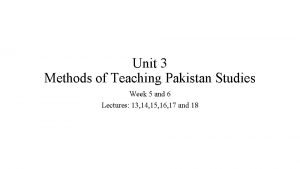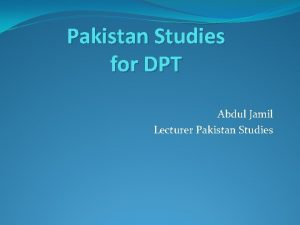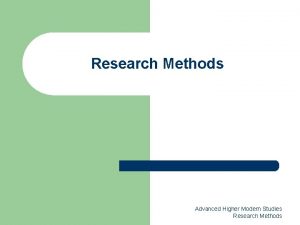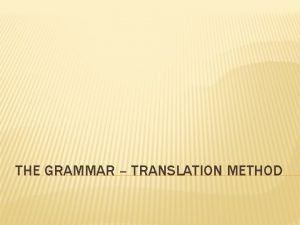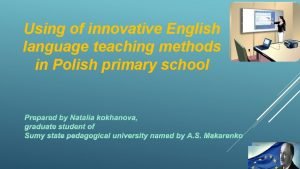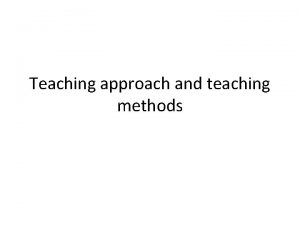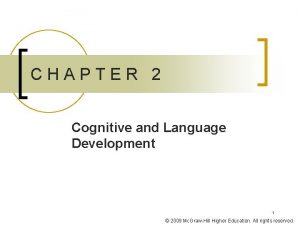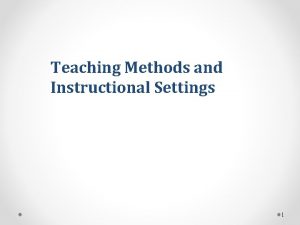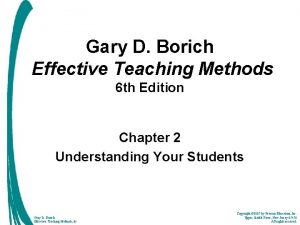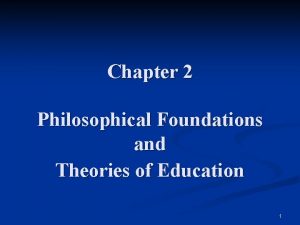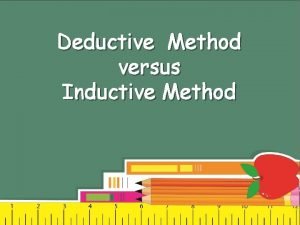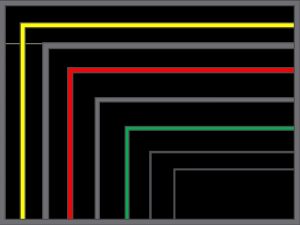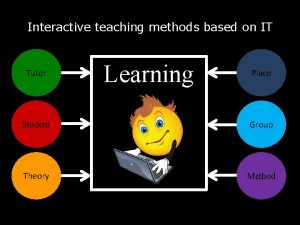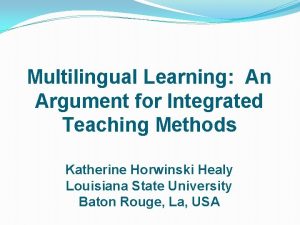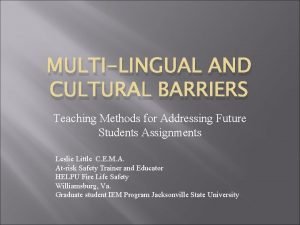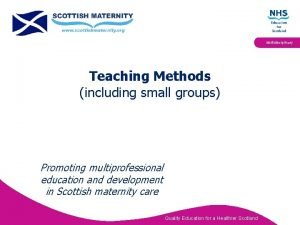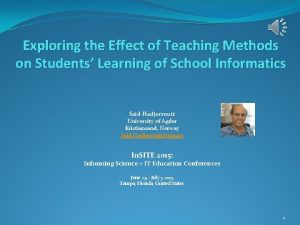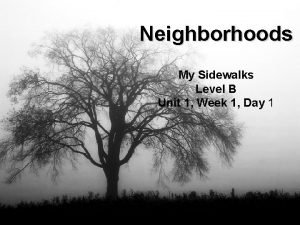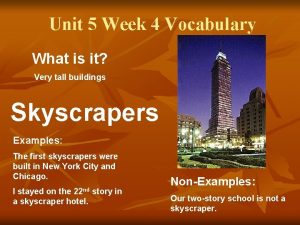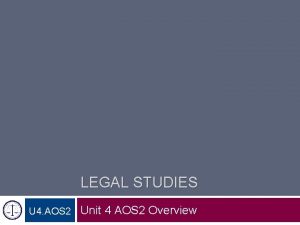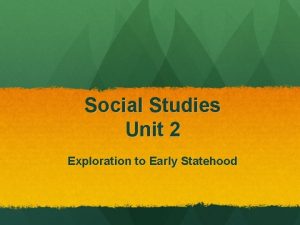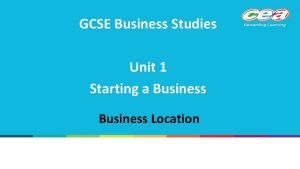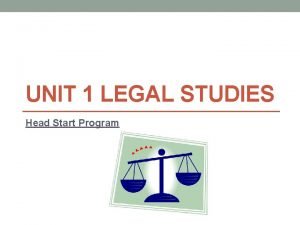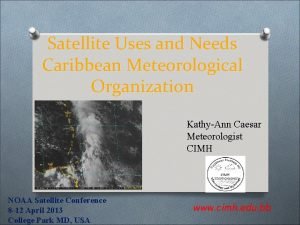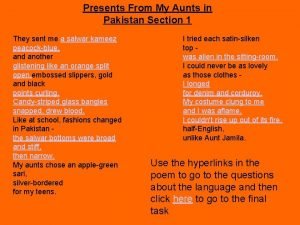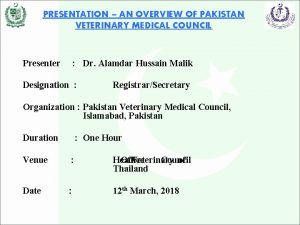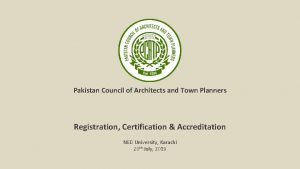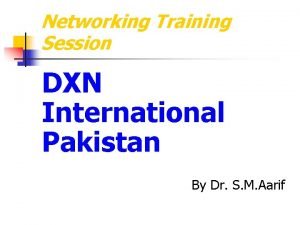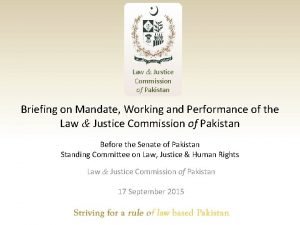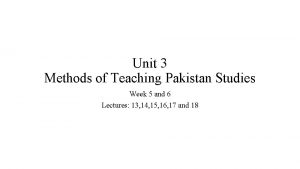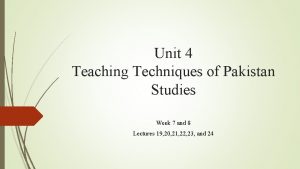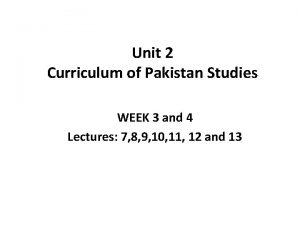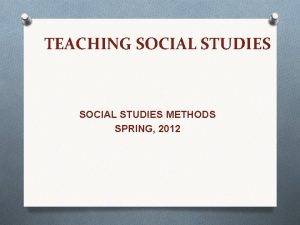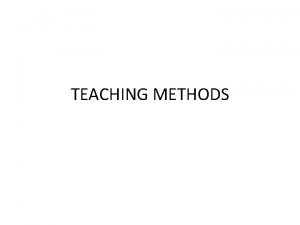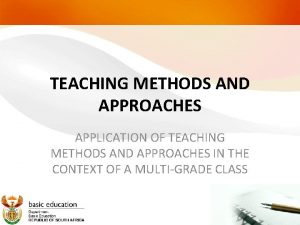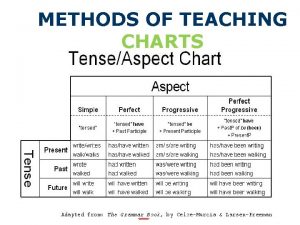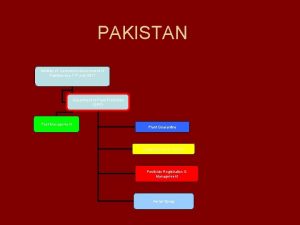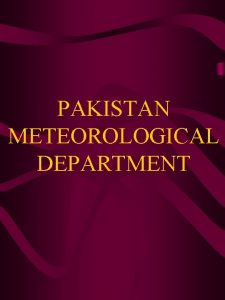Unit 3 Methods of Teaching Pakistan Studies Week













































- Slides: 45

Unit 3 Methods of Teaching Pakistan Studies Week 5 and 6 Lectures: 13, 14, 15, 16, 17 and 18

Lecture 13

Introduction • Method may be defined as a systematic procedure adopted for the attainment of some specific objectives. • The term teaching method refers to the general principles, pedagogy and management strategies used for classroom instruction.

CONT • The need for right methods of teaching cannot be underestimated in an ideal system of education. Infact the problem of method can no more be ignored in any system of educational philosophy and practice than that of the aim of the curriculum. • Even the best curriculum and the most perfect syllabus remains ineffective unless quickened into life by the right methods of teaching.

Methods of teaching Pakis Studies • Lecture Method. • Discussion Method. • Project Method. • Team Teaching Method. • Demonstration method

Lecture Method • This is a method which is generally followed in colleges and schools with big classes. In this method only the teacher talks, the students are passive listeners and they do not take any active part. Although this method is attractive, economical speedy, useful for factual information and logical sequence yet it has certain, limitations that it is memory based, emphasizes spoon feeding, too rapid, without learning by doing, authoritarian and fails to develop critical thinking.

CONT • In lecture method only the teacher talks & students are passive listeners. Since the student do not actively participate in this method of teaching, this is a teacher – controlled & information centered method. • Lecture method is most commonly followed in colleges and in schools in big classes. This method is not quite suitable to realize the real aim of teaching science.

Objectives • We use this method because of the following objectives: • To clarify • To extend contents • For the purpose of review

PLANNING THE LECTURE Before starting to prepare a lecture, the teacher must be able to answer four basic questions: • Who is your audience? - Who • What is the purpose of your lecture? - Why • How much time is available- How long • What is the subject matter? - What

Steps • The lecture follows some specific steps through which it is carried out. • Planning of a lecture • Presentation of a lecture • Introduction of a lecture • Development phase • Evaluation

Lecture 14

Merits of Lecture Method • Economical • Time Saving • Teacher’s work become easier • Useful for factual information • Develops listening skills • Useful for brilliant students • Assists other methods

Demerits of Lecture Method • Students are passive • No surety of students understanding • Weak students cannot follow • No learning by doing • Individual differences are not cared • Authoritarian method

Discussion method • The word ‘discuss’ has been derived from the Latin root ‘discutere’, which means to shake or strike. • Thus ‘discussion’ refers to thoroughly shaking up the subject, that is, examining it thoroughly to reach a conclusion. • A discussion is an activity of sitting and talking about a specific subject.

CONT • A discussion method is the means by which people share experiences, ideas and attitudes. • Discussion method enable to engage in an orderly verbal interchange and to express thoughts on a particular subject.

Discussion Method • The discussion method of teaching is a process in which small groups assemble to communicate with each other, using speaking, listening and nonverbal processes in order to achieve instructional objectives. • The most common type of collaborative method of teaching in a class is classroom discussion. It is also a democratic way of handling a class, where each student is given equal opportunity to interact and put forth their views. A discussion taking place in a classroom can be either facilitated by a teacher or by a student. A discussion could also follow a presentation or a demonstration. Class discussions can enhance student understanding, add context to academic content, broaden student perspectives, highlight opposing viewpoints, reinforce knowledge, build confidence, and support community in learning.

CONT • Discussion involves two-way communication between participants. • In the classroom situation a teacher and students all participate in discussion. • During discussion, the teacher spends some time listening while the students spend sometimes talking. • The discussion is, therefore, a more active learning experience for the students than the lecture.

Characteristics • Ensure maximum participation. • Students have the opportunity to criticize and evaluate. • Logical and meaningful criticism should be accepted. • Students should anchor the discussion themselves. • Keeping teachers as guide. • Teacher selects the topic only with the help of students.

CONT • Teacher divides the class in to different groups and gives the • • topic of the discussion to each group. Every group has a leader to anchor and conduct the discussion. Students who have leadership quality should be selected for anchoring. Relevant topic should only be considered. In the end, teacher draws the conclusion of the discussion with the help of leaders.

Advantages • Discussion method can develop following abilities among students: • Thinking and communicating powers • Leadership quality • Expression ability • Problem solving ability • Creativity • Motivation and confidence

CONT • Increase students interest • Increases students acceptance and commitments. • Utilizes student knowledge and experience. • Results in more permanent learning because of high degree of student participation.

Disadvantages • Require highly skilled instructor. • Requires preparation by student. • Limits content. • Consumes time. • Restricts size of groups.

Lecture 15

Demonstration method • Demonstrating, which is also called the coaching style or the Lecture-cum-Demonstration method, is the process of teaching through examples or experiments. • It is one of traditional method. This is also known as Chalk and talk method. In this method Teacher is active and learners are passive. Lecture-cum-demonstration includes the merits of the lecture as well as demonstration method. Demonstration means ‘to show’. In Lecture method teacher just tells but in demonstration method teacher shows and illustrates certain fundamental phenomena.

Characteristics • Characteristics of good demonstration: • Visibility & Clear cut • Convincing & Rehearsal • Supplemented with other teaching aids • Asking relevant questions • Neat, clean and tidiness • Simple and speedy • Teacher to act as performer

Advantages • Advantages of Lecture-cum-Demonstration Method: • Save time and money. • Student participation. • Helpful to promote useful discussion. • Activity method • Can be presented to large groups. • Builds confidence • Reduces damages and waste. • Promotes safety.

Disadvantages • • • Require careful preparation and rehearsal. Requires special classroom arrangements. Requires tools and equipment. Requires large block. Requires more instructors. Visibility: Visibility is main problem for a teacher because all the students may not be able to see the details and results of a demonstration • Speed of experiment: Either too fast or too slow speed of demonstration sometimes may create trouble • Ignore individual difference: This method totally ignores the main principle of psychology. • Not useful for developing scientific attitude

Lecture 16

Project method • Project method is one of the modern method of teaching in which, the students point of view is given importance in designing the curricula and content of studies. This method is based on the philosophy of Pragmatism and the principle of ‘Learning by doing’. In this strategy pupils perform constructive activities in natural condition. A project is a list of real life that has been imparted into the school. It demands work from the pupils.

Characteristics • It takes the student beyond the walls of the class room. • It is carried out in a natural setting, thus making learning realistic and experiential. • It encourages investigative learning and solution of practical problems. • It is focused on the student as it enlists his/her active involvement in the task set. • Teacher plays a facilitative role rather than the role of an expert.

CONT • Teacher plays a facilitative role rather than the role of an expert. • It allows the students a great degree of freedom to choose from among the options given to them; hence it provides a psychological boost. • It encourages the spirit of research in the student.

Steps of project method 1. Creating Situation: • In the first step teacher creates the proper situation to the students in the class. He puts up the knowledge about the project method procedure, steps, and uses to the students. • A project should arise out of a need felt by students and it should never be forced on them. It should be purposeful and significant.

CONT • 2. Selection of the problem • The teacher helps the students to select the problem and guide them. Students are having freedom to choose the topic or problem based on their interest and ability. • 3. Planning: • The teacher discuss with the students about the problem in various angles and points. • After the free expression of the students’ opinion about the problem, the teacher writes down the whole program of action stepwise on the blackboard.

CONT • In the process of planning teacher has to act only as a guide and should give suggestions at times but actual planning be left to the students. • 4. Execution • The students are stating their work in this step. They are collecting the relevant information and materials at first. The teacher should give the time and right to the students according to their own speed, interest and ability.

CONT • Evaluation of the project should be done both by the pupils and the teachers. Here the students evaluating their task. They determine whether the objects are achieved or not. After that they criticize and express their feeling about the task freely. The evaluation of the project has to be done in the light of plans, difficulties in the execution and achieved results.

Lecture 17

Reporting and Recording • It is the last step of the project method in which each and every step of the work are reported. The reported things are recorded in a certain order in a book form. • It should include the proposal, plan and its discussion, duties allotted to different students and how far they were carried out by them. It should also include the details of places visited and surveyed guidance for future and all other possible details. • The book formatted report is submitted to the teacher at the end.

Advantages • Based on psychological principal • Child centered • Fulfils the needs of all students • Promotes critical thinking • Links with real life situation • Promotes social development • Working at own pace • Democratic method

CONT • Time consuming • All syllabus cannot be covered • Costly • Need teacher expertise • No systematic coverage of curriculum • Material not available

Team Teaching • Team teaching is a method of coordinated classroom teaching involving a team of teachers working together with a single group of students.

Types of team teaching 1. 2. 3. A team of teachers from same department. A team of teachers from inter-department but from the same institutions. A team of teachers from inter-institution.

Lecture 18

Objectives of team teaching • To make the best use of experts of teacher under team teaching • To improve the quality of teaching. it involves two or more experts of the subject to teach same group simultaneously. • To develop the feelings of co-operation or group work in teaching learning situation. • To help the students, to satisfy the needs and difficulties relating to the special content. • To develop the, sense of shared responsibility in teaching and evaluation of students learning outcome. • To minimize the scope of teaching wrong things to the students.

Advantages of team teaching • Utilizes the competencies of the teachers. • Creates learning environment. • Opportunity for free discussion • Development of social relationship • Opportunity for teachers to develop professional status • Learners are benefited by the special knowledge by various teachers • It considers the need and difficulty of students. • Its an economical teaching device • It utilizes the teaching aids and equipments of teaching in an appropriate manner • Bring excellence in teaching.

Disadvantages of team teaching 1. Difficult to seek co-operation among teachers 2. Feasible in practice to assign powers. 3. No mutual regard and respect among teachers every teacher consider himself as an expert of the subject 4. Generally they are of the opinion in western countries not here in Pakistan or India.
 Unit method for teaching pakistan studies
Unit method for teaching pakistan studies Definition of pakistan studies
Definition of pakistan studies Week by week plans for documenting children's development
Week by week plans for documenting children's development Paradigm shift from women studies to gender studies
Paradigm shift from women studies to gender studies Advanced higher modern studies understanding standards
Advanced higher modern studies understanding standards Translation
Translation A-wax pattern recognition
A-wax pattern recognition Innovative teaching methods in english
Innovative teaching methods in english Characteristics of good teaching methods
Characteristics of good teaching methods Piaget teaching methods
Piaget teaching methods Definition of teaching method
Definition of teaching method Remedial teaching means
Remedial teaching means Direct/expository instruction approach
Direct/expository instruction approach Ethurom
Ethurom Pragmatism teaching methods
Pragmatism teaching methods The role of teacher in direct method
The role of teacher in direct method Deductive method of teaching
Deductive method of teaching Purpose of teaching method
Purpose of teaching method Interactive teaching methods
Interactive teaching methods Multilingual teaching methods
Multilingual teaching methods Multilingual teaching methods
Multilingual teaching methods Set dialogue closure
Set dialogue closure Methods of teaching slideshare
Methods of teaching slideshare Phases in micro teaching
Phases in micro teaching Unit 10, unit 10 review tests, unit 10 general test
Unit 10, unit 10 review tests, unit 10 general test List of things a to z
List of things a to z Diving suit
Diving suit Unit 5 week 4
Unit 5 week 4 Legal studies unit 4 aos 2
Legal studies unit 4 aos 2 Unit 3 statistical studies answers
Unit 3 statistical studies answers Business studies unit 1
Business studies unit 1 Social studies unit 2 test answers
Social studies unit 2 test answers Business studies unit 1
Business studies unit 1 Legal studies unit 1
Legal studies unit 1 Basket method is used to dispense medication to
Basket method is used to dispense medication to Disadvantage of tourism
Disadvantage of tourism Food safety standards
Food safety standards Ramsdis
Ramsdis Presents from my aunts in pakistan poem
Presents from my aunts in pakistan poem Pear paragraph structure
Pear paragraph structure Brig ajit meelu
Brig ajit meelu Pakistan oxygen limited
Pakistan oxygen limited Pcatp firm registration
Pcatp firm registration Dxn international pakistan
Dxn international pakistan Why pakistan is known for its unique vocals
Why pakistan is known for its unique vocals Law and justice commission of pakistan
Law and justice commission of pakistan
